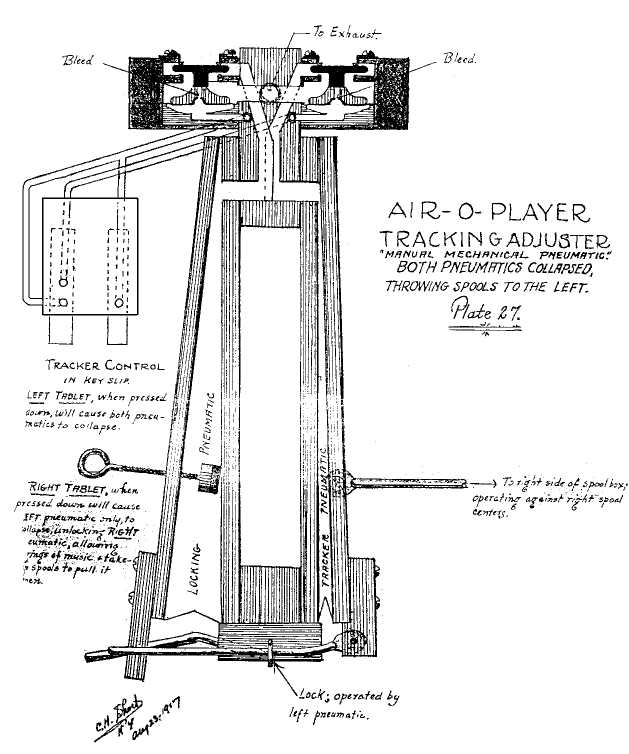| You Are Not Logged In | Login/Get New Account |
|
Please Log In. Accounts are free!
Logged In users are granted additional features including a more current version of the Archives and a simplified process for submitting articles. |
|
MMD
 Tech
Tech
 airOplayer
airOplayer
|
|
drawing by C. H. Short, August 23, 1917 by Robbie Rhodes
During several months in 1917, Mr. C. H. Short, of Pomona, California, attended the Danquard Player Action School in New York City, where he enjoyed making detailed drawings of player piano roll tracking mechanisms. The illustration above is from a photocopy of Mr. Short's 3-ring loose-leaf notebook. (The location today of the original notebook isn't known.) A short article in Music Trade Review circa 1918 says that Mr. Short was the 152nd Danquard graduate and was considered "one of the most studious graduates that has ever received a diploma from this school." A few of the drawings in his notebook are dated in 1920s in New York, which hints that Mr. Short returned to Danquard for an unknown period, perhaps to teach. I recently asked a retired local school teacher about him, and I learned that in the 1950s Mr. Short was still active maintaining and tuning pianos in homes and schools nearby Pomona and Claremont, Calif. When he retired his practice was assumed by master technician Francis Mehaffey of Pomona Valley PTG. This 1917 description of the Air-O-Player player piano action and the tracking mechanism operation is given by Mr. Short. Note that only the pneumatic on the right moves the spools. The pneumatic on the left operates a locking device. - - - AIR-O-PLAYER 1. Tracking device: manual mechanical tracker adjuster, also manual mechanical pneumatic tracker adjuster. 2. 5 point pneumatic motor. 3. Action. Single valve, vertical. Bleeds are location in valve stems. To get at, remove valve units from front of action and take out the valve stems. To get at this valves, unscrew two screws on top of valve unit, take out atmospheric seat and valve. 4. Lost motion between player and piano action taken up by dowels in rear of player action, or preferably bo a device on each pneumatic operated by a screw accessible from the from of the player action. This screw is located in the pneumatic lug. 5. Players attacks the piano action against the under side of the wippens. 6. Hammer blow regulation and checking of the pneumatic taken care of by device on the piano action. 7. Top action exhausted from treble end only. This is not a divided action. Bottom action 8. Center driven exhausters. 9. Center connected treadles. 10. One equalizer. No crash valves. 11. Two governors, one for motor, one for top action. 12. Bottom action: Indirect type. - - - AIR-O-PLAYER
Tracker control in key slip. The left tablet, when pressed down, will cause both pneumatics to collapse. The right tablet, when pressed down, will cause the left or locking pneumatic to collapse, releasing the right pneumatic, allowing the springs on the music roll and take-up spool shafts to pull it [the right pneumatic] open. Plate 26 - Normal position, right pneumatic about 2/3 open.
06 April 2003 |
|
|
|
|
|
|
|
|
|
CONTACT FORM: Click HERE to write to the editor, or to post a message about Mechanical Musical Instruments to the MMD Unless otherwise noted, all opinions are those of the individual authors and may not represent those of the editors. Compilation copyright 1995-2026 by Jody Kravitz. Please read our Republication Policy before copying information from or creating links to this web site. Click HERE to contact the webmaster regarding problems with the website. |
|
|
||||||
|

